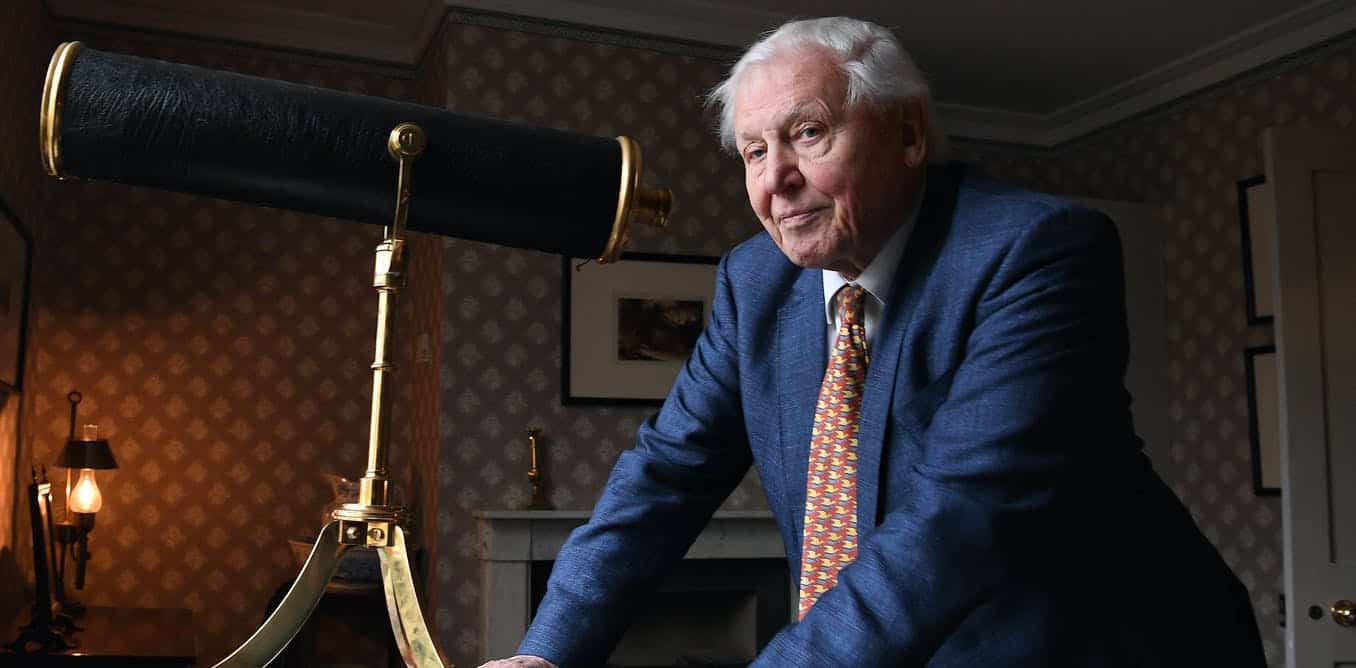

Image Andy Rain / EPA
At a recent event on the history of wildlife documentaries, I was asked a question that has popped up regularly in my 15 years of research: “Who, do you think, will replace David Attenborough?”
Now that Sir David is gradually drawing his career to a close with the latest BBC documentary A Perfect Planet, the question appears more topical than ever. But still nobody has emerged to replace him at the top of the food chain. The short answer is that no one can replace David Attenborough because wildlife television – in Britain at least – is constructed around him. Take him away and the whole thing needs to be reinvented.
That Attenborough is irreplaceable has nothing to do with his exceptional individual qualities, but owes everything to the way he’s reached his position as the front-of-the-house person of British wildlife television. For sure, he is a mesmerising storyteller. Yet wildlife television as it is experienced in Britain today came into being over several decades, and one outcome of this process was to establish Attenborough’s skills and approach as the gold-standard, and the man himself as the queen in the hive. https://www.youtube.com/embed/692fiaoJWy8?wmode=transparent&start=0 Attenborough has been on TV since the days of clipped ‘BBC English’ accents.
Attenborough began his work at the BBC in 1953. At the time, Peter Scott was the voice and face of nature on British television. Scott’s series Look was the BBC’s flagship programme and the standard every aspiring wildlife filmmaker aimed for.
With Look, Scott had transferred radio programmes to TV, adding images to the spoken word. In each episode, Scott introduced the work of amateur wildlife cameramen, on which he would improvise a loose commentary, before engaging in a rather guarded conversation with the filmmaker.
By contrast, at the same time, Attenborough was busy producing the successive Zoo Quest series. By the end of the decade, these story-based, scripted programmes, which took viewers on an adventure of discovery had become the most popular animal programmes on British television.
In 1965, Attenborough became BBC Two controller. In the years that followed, the BBC Natural History Unit in Bristol began to diversify its output. One strategy was to turn to Attenborough.
First as a model, when for example the unit recruited the naturalist Gerald Durrell to appear in clones of the Zoo Quest programmes in which Durrell could be seen collecting animals for his Jersey Zoo. Then as a contributor, in an effort to import “the Attenborough style” from London to Bristol, notably his habit of scripting in detail the commentary for his programmes, paying close attention to how the words matched the images.
During his tenure in BBC management from 1965 to 1972, Attenborough profoundly reformed wildlife television. Getting rid of Look, he severed the link with amateur natural history, instead forging an association with scientists working on animal behaviour and evolution through programmes such as Life.
He also promoted the use of pre-recorded material over live sequences, instituting post-production as the key moment in wildlife television-making. Tightly controlled visual performances resting on skilled presenters could then be assembled to produce specific effects on viewers.
When, in November 1972, David Attenborough resigned from his managing position to become a freelance programme maker for the BBC, the professional culture of wildlife television making had changed in such a way that it was easier for him to play a central role in it as a presenter.
From the moment he became a freelancer, the BBC took an active part in fashioning David Attenborough as the voice and face of nature on British television. One of his first contracts with the Natural History Unit was to record the commentary for several episodes of the BBC film-based series The World about Us, which Attenborough himself had launched in 1967 when controller of BBC Two.
Then came Eastward with Attenborough in 1973. The series set in Borneo was meant to reconnect Attenborough with his public. Positive reviews framed the series as the return of the prodigal son of wildlife television. And in 1977 he became the narrator of the weekly series Wildlife on One, which ran until 2005.
But it was with Life on Earth (1979) that a new approach to producing wildlife television that rested entirely on Attenborough’s performance materialised. Scripting the series and working hand in hand with the producers in Bristol, Attenborough invented for himself the pivotal role of wildlife television writer and performer, wildlife storyteller.
In this role, he did not work for the series producers. Instead they worked for him, providing him with the visual background for his storytelling performance. Attenborough was aware that Life on Earth would consolidate his reputation, as he opposed any contract that would replace him with another presenter for the American version.
The decades since have been dominated by documentaries that are entirely dependent on Attenborough’s involvement and revolve around his performance as a wildlife storyteller. Replacing him will entail changing the very style of programmes that are produced.
Just like a new queen bee has to leave the hive and establish its own colony, for another personality to rise and become as central to wildlife television as David Attenborough is today, wildlife television will have to be reinvented, and different ways of showing nature on TV will have to be found.
What these will be, nobody can predict. My hunch is that it might involve fewer grand vistas and a return to amateur natural history with more down-to-earth, “wildlife on your doorstep” kind of programming.
Jean-Baptiste Gouyon, Associate professor in Science Communication, UCL
This article is republished from The Conversation under a Creative Commons license. Read the original article.